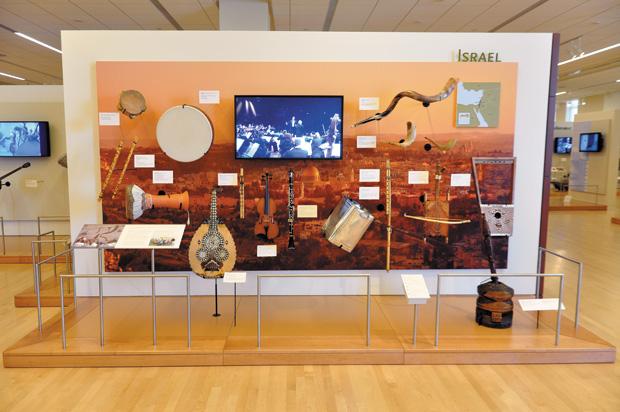Noted collection: Museum’s collection includes Israeli, klezmer instrument displays
Published October 3, 2012
PHOENIX, Ariz. — The Musical Instrument Museum, which opened here two years ago, displays an extraordinary collection of more than 10,000 instruments played throughout the world. Exhibits are arranged by nation, and Israel has its own space within the Middle East gallery. A separate display of Klezmer instruments is included as part of the United States gallery.
“We recently expanded our Israel exhibit,” says Colin Pearson, who curates the Middle East and Asia galleries. “Because Israel is very young, and consists of citizens who originate from all over the world and who brought their own traditions and music, I felt it was important to show instruments that represent that diversity. I also wanted to incorporate videos clips to demonstrate some of the ways Israelis are simultaneously preserving their cultural heritage and creating new musical genres.”
The backdrop for the exhibit is a panorama of the Jerusalem skyline, with actual instruments and a television monitor in the foreground. Some of the instruments featured include:
• A Bedouin jooroon. Actually a mortar-and-pestle used to grind coffee, this instrument is also an accompaniment to singing with the pestle being pounded to keep time to the music. Hospitality is an important part of Bedouin life, and when Bedouins welcome visitors to their tent, it is traditional to offer coffee, which they pound rhythmically in the mortar. Bedouins also play the mortar to provide rhythmic accompaniment to traditional songs. “It is a perfect utilitarian instrument for a nomadic lifestyle,” Pearson says, adding that museum’s instrument was made by a Bedouin sheik.
• An Arabic ‘ud (plucked lute). The pear-shaped ‘ud is one of the most popular instrments in the Middle East, but this one is uniquely Israeli—it was made by a respected maker and is decorated with Jewish iconography. It is thought to have been commissioned by a rabbi.
• A darbuka. Shaped like a goblet and made of clay, the darbuka is a drum with a fish skinhead. The one on display here has been adapted to include an electric light bulb under the drum skin. When turned on it heats the skin keeping the instrument in tune.
The display also includes several shofars. Although they are not used to play music, Pearson says the curators decided to add ceremonial instruments throughout the museum “because the line between music and ceremony can become blurred at times.” Other examples of ceremonial instruments include large Indonesian gongs, which are special drums used in Tibetan Buddhist meditation ceremonies, and conch horns used as ceremonial trumpets throughout Pacific Islands.
“Also, we wanted to include the shofar because of its heritage,” Pearson says. “Not only is it an iconic instrument for the Jewish people, but it also is the only Biblical instrument we are certain has been in continual use since ancient times, and it remains exactly as it has always appeared.”
Videos, showing the instruments being played, are integral to the museum experience. In fact, because of the videos, the museum is promoted as “the most extraordinary museum you’ll ever hear.”
For the Israel exhibit Pearson has chosen six videos that illustrate a broad range of the nation’s music. The examples include Klezmer music, a Jewish Yemenite song with tin drum accompaniment, various Arab instruments, the Israel Philharmonic Orchestra, and a performance by Israeli folk singer and guitarist Chava Alberstein, recorded in museum’s Music Theater. Together they help illustrate a variety of the ways that Israeli musicians are actively preserving their traditions and creating new ones.
“The orchestral music in this exhibit tends to surprise guests the most,” says Pearson. “They just don’t expect to hear it in the Middle East. The reality is that European classical music is taken very seriously in Israel, and the Israel Philharmonic Orchestra has been internationally renowned for decades. One of the videos is of Pinchas Zuckerman playing a violin concerto by Max Bruch with the (Philharmonic) under the direction of (Israeli conductor) Zubin Mehta.”
Klezmer instruments are exhibited within the U.S. gallery as an example of different forms of music that were an important part of the immigrant experience in America. Jewish immigrant diversity is evident in the origin of the instruments, which includes a German trombone and coronet, an American clarinet, a violin from the Czech Republic, and a Russian accordion.
Several instruments associated with Judaism are also exhibited elsewhere. An ornately decorated shofar is one of the first instruments every visitor encounters in the orientation gallery where a display previews what is to be seen throughout the museum. “It is a very long kudu horn, which is typically identified with Yemenite Jews,” Pearson says noting that the silver decorations wrapped around the horn depict the old city of Jerusalem and an olive branch. “It was a new instrument when the museum purchased it in 2008. The enormous size and elaborate silver decoration imply it was created as a presentation piece.”
A 1900-era Austrian mandolin once owned by Gittel Lipmann is displayed in the Austria exhibit. Museum documents show he had the instrument while a prisoner of war in Theresienstadt, a World War II Nazi concentration camp in what is now the Czech Republic. “Unfortunately we know nothing more about him or how the instrument survived,” Pearson says. “Still, we thought it was important to show the instrument in the exhibit and share what we know of its story.”
The soundtrack to the video section in each display is heard through headphones included with the $15 adult admission. Soundtracks are activated as visitors walk between exhibits, and the smorgasbord of music seamlessly fades in and out. The result is ample evidence of the harmony music creates among all people, no matter how primitive or advanced.















